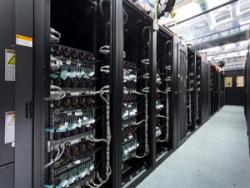One of three questions that forms the foundation of Professor Debra Fischer’s “Origins and the Search for Life in the Universe” (ASTR 130) asks “What are we doing to find life elsewhere?” Part of the answer to that question is that her research team, and many others around the world, are searching for planets orbiting stars other than our sun. When an exoplanetary system is detected, there are uncertainties and incomplete information; in particular, the mass of the planets is often uncertain. Astronomers can place upper limits on planetary masses by carrying out numerical simulations to check for gravitational perturbations that would destabilize the orbit of the planet. This is work that generally requires the expertise of “rocket scientists” - astrophysicists who are specialists in modeling dynamical interactions between several bodies.
 Professor Fischer wanted her students (most of whom are non-science majors) in this introductory class to appreciate how mathematical modeling is impacting our lives - from financial markets to climate change - and why it is important to understand the strength and limitation of these models. Pedagogically, her goal was to shift from plug and play problems to the development of higher order thinking skills (creating, analyzing) and give her students the opportunity to be immersed in the authentic problem-solving approaches of scientists.
Professor Fischer wanted her students (most of whom are non-science majors) in this introductory class to appreciate how mathematical modeling is impacting our lives - from financial markets to climate change - and why it is important to understand the strength and limitation of these models. Pedagogically, her goal was to shift from plug and play problems to the development of higher order thinking skills (creating, analyzing) and give her students the opportunity to be immersed in the authentic problem-solving approaches of scientists.
With support from the Rosenkranz Grants for Pedagogical Advancement, she engaged staff from Information Technology Services, the Center for Teaching and Learning, and the Yale Center for Research Computing to develop a user-friendly interface to the professional astronomy software that runs on Yale’s High Performance Computing environment (below right). The “Orbital Simulator” inputs data about a planetary system, including the number of planets, their mass, orbital radius, etc. Students begin by finding and selecting an exoplanetary system that has been identified by astronomers. They assemble and interpret the available data, and in some cases have to transform it or interpolate missing data before submitting it to the simulator.

The simulator then computes the behavior of the planetary system over millions of years, a simulation that can take many hours to complete. When complete, students use software tools to generate specific plots to elucidate gravitational interactions between orbiting exoplanets. For example, one plot shows a diagram of the planetary orbits and shades the so-called habitable zone; another plot traces the eccentricity of the orbits over time; another plot shows the planets moving closer or further away from the host star over time because of gravitational tugs from other planets.
Most science classes ask students to apply concepts in the homework problems. In setting up the orbital simulation for multi-planet systems, the students were challenged to think outside of that box. What should they do when they have missing information? How can they extrapolate from the known to the unknown? How do they work with measurement uncertainties that limit their knowledge of the underlying truth? What information do models provide, and what are their limitations? These are challenges that face visionary leaders across fields in “the real world.”
There are now a few hundred multi-planet systems that have been discovered around other stars. Students enrolled in ASTR 130 signed up for their own unique multi-planet system at the beginning of the semester. Several of the homework problem sets during the semester connected back to these individual systems (calculation of the inner and outer boundaries of the habitable zone, calculating the peak wavelength for the energy distribution from stars, application of the Stefan-Boltzmann equation, deriving missing information on stars and planetary systems) in preparation for the capstone project: carrying out the N-body simulation of a multi-planet system and writing a semester paper. Professor Fischer notes that “In many cases, professional astronomers had never carried out this work and this constituted original research on the part of Yale undergrads; these students are non-science majors.”
For the last homework assignment, students carried out a simulation of our solar system – here they learned that the planets interact strongly thanks to the dominant gravitational effect of Jupiter. They were then invited to “stress test” the solar system – to ask a question (e.g., what happens to the stability of the solar system if we have a “hot Jupiter”? Could other planets reside in stable orbits in our solar system?) and then to find the answer to that question by using the Orbital Simulator.
Professor Fischer was delighted with the outcomes: “The success of the students was incredible. One student uncovered instabilities in a triple-planet system that suggests that the published orbital parameters are incorrect. The simulations by the ensemble of the one hundred and twenty ASTR130 students surprised me with the remarkable stability of multi-planet systems discovered with the NASA Kepler mission and highlighted some fascinating issues that will lead to new research investigations. “
For more information about the grant that funded this work, see our page about the Rosenkranz Grants for Pedagogical Innovation.
